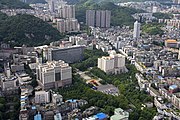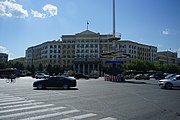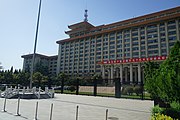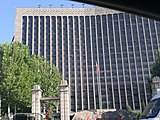| Province-level divisions 省级行政区 Shěngjí Xíngzhèngqū | |
|---|---|
 Provinces
Autonomous regions
Municipalities
Special Administrative Regions Provinces
Autonomous regions
Municipalities
Special Administrative Regions | |
| Category | Unitary state |
| Location | |
| Number | 33-34 (1 claimed) |
| Government | |
| Subdivisions | |
| Province-level administrative divisions | |||||||
|---|---|---|---|---|---|---|---|
| Simplified Chinese | 省级行政区 | ||||||
| Traditional Chinese | 省級行政區 | ||||||
| |||||||
China is officially (de jure) divided into 34 province-level administrative divisions, the first level of administrative division in the country. There are four types of divisions at the province level:
- Provinces (23)
- Autonomous regions (5)
- Municipalities (4)
- Special Administrative Regions (SARs; 2)
Province-level divisions can trace their origins back to the Yuan dynasty. The political status of Taiwan Province, as well as small portions of other provinces, are disputed.
Government
The legislative branch at the provincial level is the People's Congress, modeled on the National People's Congress. Provincial People's Congresses have had legislative powers since 1979, and pass laws on a wide variety of issues. The executive branch is the Provincial People's Government, led by a governor in the provinces, a mayor in provincial-level cities, a chairman in the autonomous regions. The head of the government is assisted by a number of subordinate officials such as Vice-Governors. The head of the People's Government is appointed by the State Council. That said, the People's Governments are responsible to both the State Council and the regional People's Congress, and implement the decisions of both bodies. They also pass the State Council's instructions down to the lower levels of the administration. Province-level governments have the power to set budgets and raise revenue, although they are subject to the State Council's approval. They can pursue development projects without seeking central government approval.
Provincial level party structure
As with the central government, province-level divisions are governed by parallel party and state structures. Each province-level branch of the Chinese Communist Party (CCP) holds a Party Congress every five years. The congress will elect a Party Committee, which in turn elects a Standing Committee. The Standing Committee includes a party secretary, who is the leader of the CCP in that province-level division. The Standing Committee usually includes the top members of the People's Government as well.
Provincial People's Government buildings
-
 Anhui Provincial People's Government Building
Anhui Provincial People's Government Building
-
 Fujian Provincial People's Government Building
Fujian Provincial People's Government Building
-
 Guizhou Provincial People's Government Building
Guizhou Provincial People's Government Building
-
 Heilongjiang Provincial People's Government Building
Heilongjiang Provincial People's Government Building
-
 Shaanxi Provincial People's Government Building
Shaanxi Provincial People's Government Building
-
 Shanxi Provincial People's Government Building
Shanxi Provincial People's Government Building
-
 Yunnan Provincial People's Government Building
Yunnan Provincial People's Government Building
History
Main article: History of the administrative divisions of China (1949–present) Further information: History of the administrative divisions of ChinaThe first province-level divisions were created in the Yuan dynasty, and have remained one of the most stable forms of Chinese government since then. They were created to help the Imperial court manage local county governments, which were too numerous and far-flung to be managed directly. The number of provinces grew steadily during subsequent dynasties, reaching 28 by the time of the Republic of China. Under the Nationalist Government, large cities began to be classified separately from other administrative units. Starting in 1930, some of these "special cities" became "direct jurisdiction cities" under the central government, the predecessor of province-level cities. During the Warlord Era, provinces became largely or completely autonomous and exercised significant national influence. Province-level units proliferated and under the early People's Republic there were over 50.
In the mid-1950s, the People's Republic (PRC) made several major reforms to province-level administration. Despite closely modelling other aspects of the PRC on the Soviet Union, the CCP's experience with territorial disintegration during the Warlord Era led them to reject the Soviet federal structure. Instead, the total number of provinces was significantly reduced and the unitary state structure was retained. Most direct jurisdiction cities were abolished, although a few became province-level cities. Limited autonomy was granted to ethnic minorities in five new "Autonomous Regions" (see below). People's Congresses were set up to run province-level governments. During the Cultural Revolution, these Congresses each elected a revolutionary committee to exercise both executive and legislative power when they were not in session. Province-level divisions had limited independent authority before the period of Reform and Opening-up, due to the centrally planned nature of the economy. Their main role was to implement the decisions made by the central government regarding production goals, raising and spending of revenue, and resource allocation. However, in contrast with the Soviet system, there was some degree of regional autonomy. Many provincial governments ran smaller manufacturing firms independently of the central government. Since 1979, the central government has granted increased decision-making authority to provincial level governments. In turn, they have devolved the power to make local regulations to cities and other local governments.
List of province-level divisions
| GB/T 2260-2007 | ISO | Province | Chinese Hanyu Pinyin |
Capital | Population | Density | Area | Abbreviation |
|---|---|---|---|---|---|---|---|---|
| AH | CN-AH | Anhui Province | 安徽省 Ānhuī Shěng |
Hefei | 61,027,171 | 436.29 | 139,879 | 皖 Wǎn |
| BJ | CN-BJ | Beijing Municipality | 北京市 Běijīng Shì |
Tongzhou | 21,893,095 | 1,334.05 | 16,411 | 京 Jīng |
| CQ | CN-CQ | Chongqing Municipality | 重庆市 Chóngqìng Shì |
Yuzhong | 32,054,159 | 388.99 | 82,403 | 渝 Yú |
| FJ | CN-FJ | Fujian Province | 福建省 Fújiàn Shěng |
Fuzhou | 41,540,086 | 335.66 | 123,756 | 闽 Mǐn |
| GD | CN-GD | Guangdong Province | 广东省 Guǎngdōng Shěng |
Guangzhou | 126,012,510 | 700.02 | 180,013 | 粤 Yuè |
| GS | CN-GS | Gansu Province | 甘肃省 Gānsù Shěng |
Lanzhou | 25,019,831 | 54.70 | 457,382 | 甘(陇) Gān (Lǒng) |
| GX | CN-GX | Guangxi Zhuang Autonomous Region | 广西壮族自治区 Guǎngxī Zhuàngzú Zìzhìqū |
Nanning | 50,126,804 | 210.78 | 237,818 | 桂 Guì |
| GZ | CN-GZ | Guizhou Province | 贵州省 Guìzhōu Shěng |
Guiyang | 38,562,148 | 218.93 | 176,140 | 贵(黔) Guì (Qián) |
| HA (HEN) | CN-HA | Henan Province | 河南省 Hénán Shěng |
Zhengzhou | 99,365,519 | 600.52 | 165,467 | 豫 Yù |
| HB (HUB) | CN-HB | Hubei Province | 湖北省 Húběi Shěng |
Wuhan | 57,752,557 | 310.87 | 185,776 | 鄂 È |
| HE (HEB) | CN-HE | Hebei Province | 河北省 Héběi Shěng |
Shijiazhuang | 74,610,235 | 393.08 | 189,809 | 冀 Jì |
| HI | CN-HI | Hainan Province | 海南省 Hǎinán Shěng |
Haikou | 10,081,232 | 294.27 | 34,259 | 琼 Qióng |
| HK | CN-HK | Hong Kong Special Administrative Region | 香港特别行政区 Xiānggǎng Tèbié Xíngzhèngqū |
Tamar | 7,061,200 | 6,396.01 | 1,108 | 港 Gǎng |
| HL | CN-HL | Heilongjiang Province | 黑龙江省 Hēilóngjiāng Shěng |
Harbin | 31,850,088 | 67.37 | 472,766 | 黑 Hēi |
| HN (HUN) | CN-HN | Hunan Province | 湖南省 Húnán Shěng |
Changsha | 66,444,864 | 313.65 | 211,842 | 湘 Xiāng |
| JL | CN-JL | Jilin Province | 吉林省 Jílín Shěng |
Changchun | 24,073,453 | 126.51 | 190,282 | 吉 Jí |
| JS | CN-JS | Jiangsu Province | 江苏省 Jiāngsū Shěng |
Nanjing | 84,748,016 | 847.91 | 99,949 | 苏 Sū |
| JX | CN-JX | Jiangxi Province | 江西省 Jiāngxī Shěng |
Nanchang | 45,188,635 | 270.69 | 166,939 | 赣 Gàn |
| LN | CN-LN | Liaoning Province | 辽宁省 Liáoníng Shěng |
Shenyang | 42,591,407 | 289.59 | 147,076 | 辽 Liáo |
| MO | CN-MO | Macau Special Administrative Region | 澳门特别行政区 Àomén Tèbié Xíngzhèngqū |
552,300 | 19,044.82 | 29 | 澳 Ào | |
| NM | CN-NM | Inner Mongolia Autonomous Region | 内蒙古自治区 Nèi Měnggǔ Zìzhìqū |
Hohhot | 24,049,155 | 20.05 | 1,199,372 | 蒙(绥) Měng (Suí) |
| NX | CN-NX | Ningxia Hui Autonomous Region | 宁夏回族自治区 Níngxià Huízú Zìzhìqū |
Yinchuan | 7,202,654 | 108.47 | 66,400 | 宁 Níng |
| QH | CN-QH | Qinghai Province | 青海省 Qīnghǎi Shěng |
Xining | 5,923,957 | 8.58 | 690,355 | 青 Qīng |
| SC | CN-SC | Sichuan Province | 四川省 Sìchuān Shěng |
Chengdu | 83,674,866 | 174.93 | 484,056 | 川(蜀) Chuān (Shǔ) |
| SD | CN-SD | Shandong Province | 山东省 Shāndōng Shěng |
Jinan | 101,527,453 | 643.78 | 157,704 | 鲁 Lǔ |
| SH | CN-SH | Shanghai Municipality | 上海市 Shànghǎi Shì |
Huangpu | 24,870,895 | 3,922.24 | 6,341 | 沪(申) Hù (Shēn) |
| SN (SAA) | CN-SN | Shaanxi Province | 陕西省 Shǎnxī Shěng |
Xi'an | 39,528,999 | 192.24 | 205,624 | 陕(秦) Shǎn (Qín) |
| SX (SAX) | CN-SX | Shanxi Province | 山西省 Shānxī Shěng |
Taiyuan | 34,915,616 | 222.80 | 156,713 | 晋 Jìn |
| TJ | CN-TJ | Tianjin Municipality | 天津市 Tiānjīn Shì |
Hexi | 13,866,009 | 1,194.32 | 11,610 | 津 Jīn |
| TW | CN-TW | Taiwan Province | 台湾省 Táiwān Shěng |
Taipei | 23,162,123 | 650.97 | 36,161 | 台(臺) Tái |
| XJ | CN-XJ | Xinjiang Uyghur Autonomous Region | 新疆维吾尔自治区 Xīnjiāng Wéiwú'ěr Zìzhìqū |
Ürümqi | 25,852,345 | 15.72 | 1,644,707 | 新 Xīn |
| XZ | CN-XZ | Tibet Autonomous Region | 西藏自治区 Xīzàng Zìzhìqū |
Lhasa | 3,648,100 | 3.03 | 1,204,776 | 藏 Zàng |
| YN | CN-YN | Yunnan Province | 云南省 Yúnnán Shěng |
Kunming | 47,209,277 | 123.20 | 383,195 | 云(滇) Yún (Diān) |
| ZJ | CN-ZJ | Zhejiang Province | 浙江省 Zhèjiāng Shěng |
Hangzhou | 64,567,588 | 615.67 | 104,873 | 浙 Zhè |
See also
- List of Chinese administrative divisions by population
- List of Chinese administrative divisions by GDP
- List of current Chinese provincial leaders
- Tiao-kuai – Quasi-federal administration in China.
Notes
- Including the disputed Taiwan Province.
- Subordinate provincial officials are appointed by province-level committees.
- as of 2020
- per km
- km
- Abbreviation in the parentheses is informal
- Most of the Fujian Province is administered by the People's Republic of China (PRC) while the Republic of China on Taiwan includes Kinmen County (Quemoy) and Lienchiang County (Matsu) formerly under its own streamlined Fujian Province.
- Most of the Guangdong Province is administered by the People's Republic of China (PRC) while the Republic of China on Taiwan includes Pratas Island (also named Tungsha Island or Dongsha Island) as part of the Dongsha Atoll National Park.
- Most of the Hainan Province is administered by the People's Republic of China (PRC) while the Republic of China on Taiwan includes Taiping Island (Itu Aba) as part of Cijin District, Kaohsiung.
- Has separate ISO 3166-2 code:
HK - Has separate ISO 3166-2 code:
MO - Has separate ISO 3166-2 code:
TW - The People's Republic of China considers Taiwan to be its 23rd province, but Taiwan is currently administrated by the Republic of China. Since 1945, the ROC only controls the island of Taiwan and Penghu. For Kinmen and Matsu, see note on Fujian Province. See also Political status of Taiwan
References
- ^ Chung & Lam 2010, Chapter 2.
- Goodman 2015, pp. 95–96.
- Saich 2015, pp. 157–158.
- Goodman 2015, p. 96.
- Guo 2017, p. 23.
- Fitzgerald 2002, p. 16.
- Goodman 2015, pp. 150, 154.
- Fitzgerald 2002, p. 27.
- Goodman 2015, pp. 153–154.
- ^ Chung & Lam 2010, Chapter 1.
- ^ Saich 2015, p. 158.
- Zhang, LeGates & Zhao 2016, p. 89.
- Zhang, LeGates & Zhao 2016, pp. 90–92.
- "GB/T 2260 codes for the provinces of China". Archived from the original on 2004-03-05. Retrieved 2011-10-30.
- ISO 3166-2:CN (ISO 3166-2 codes for the provinces of China)
Bibliography
- Guo, Rongxing (2017). How the Chinese Economy Works (4th Revised ed.). Palgrave Macmillan.
- Goodman, David S.G. (2015). Handbook of the Politics of China. Northampton, Massachusetts: Edward Elgar Publishing Limited.
- Zhang, Li; LeGates, Richard; Zhao, Min (2016). Understanding China's Urbanization: The Great Demographic, Spatial, Economic, and Social Transformation. Northampton, Massachusetts: Edward Elgar Publishing Limited.
- Saich, Tony (2015). Governance and Politics of China (Fourth ed.). New York: Palgrave Macmillan.
- Chung, Jae Ho; Lam, Chiu (2010). China's Local Administration: Traditions and Changes in the Sub-National Hierarchy. New York: Routledge.
- Fitzgerald, John (2002). Rethinking China's Provinces. New York: Routledge.
External links
- Interactive Dbresearch.com: WebMap Archived 2016-04-06 at the Wayback Machine — with economic indicators for all Chinese Provinces.
| Articles on first-level administrative divisions of Asian countries | |
|---|---|
| Sovereign states |
|
| States with limited recognition | |
Table of administrative divisions by country
| |
| Provincial-level divisions of China | ||
|---|---|---|
| Provinces |  | |
| Autonomous regions | ||
| Direct-administered municipalities | ||
| Special administrative regions | ||
| Disputed province | ||
| Taiwan is claimed by the People's Republic of China but administered by the Republic of China (see political status of Taiwan). | ||